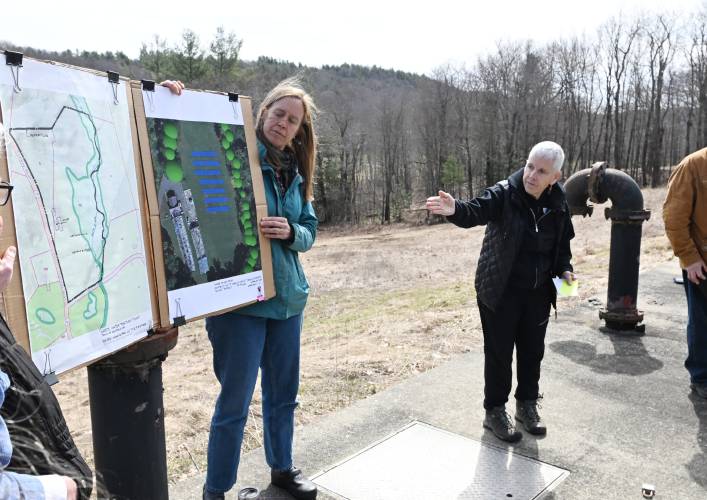As part of Climate Leader plans, Ashfield’s ‘solar journey’ just beginning
| Published: 04-08-2025 4:19 PM |
ASHFIELD — As part of its goal to cut use of fossil fuels in municipal facilities by 95.6% by 2050, town officials recently spent the day perusing sites that could help power Ashfield’s future with clean energy while reducing energy costs.
The Energy Committee has applied to the state to have the town designated as a Climate Leader Community, which is considered the next step up from a Green Communities designation and shows a community is taking actionable steps to reduce its energy use. As part of this effort, the committee is developing two solar arrays in town, and took town officials and community partners on a tour of the proposed sites last week.
Constructing solar arrays at the Ashfield Wastewater Treatment Plant and the Highway Garage could save the town $2 million in energy costs over 25 years. Should the town receive the Climate Leader designation, the next step would be to apply for a $1 million grant to cover the cost of these arrays.
“It’s a bit of a chicken and an egg. We need the project to be shovel-ready for the grant, but we need cash for delineation and some planning,” Energy Committee Chair Alex Osterman said of the projects.
The Selectboard last month signed a letter of intent with Solect Energy to build the two arrays if the grant funding comes through. The board plans to include an article on the May Annual Town Meeting warrant asking voters to approve appropriating $100,000 from the town’s Grant Match Stabilization Fund to match the Climate Leader grant and support engineering and planning work for the solar arrays.
The Energy Committee is expecting to hear whether the town will receive the Climate Leader designation later this spring, after which point it could apply for the grant funding. Applications will be due Aug. 1. If awarded, construction on the solar arrays could begin next spring.
At the Wastewater Treatment Plant on Conway Road, the Energy Committee is proposing a 179.45-kilowatt system, with an access road and chain-link fence surrounding it.
“Besides providing all the electricity to run this plant, it will also produce net generation credits. What’s leftover will be converted and go to Eversource and take care of Town Hall, the library, Fire Department, parks, beach, Transfer Station, street lights and still give us $21,000 a year,” Energy Committee member Mary Quigley said.
Article continues after...
Yesterday's Most Read Articles
 Turners Falls man pleads guilty to child porn charges
Turners Falls man pleads guilty to child porn charges
 Petition seeks removal of Tucker Jenkins from Shelburne Police
Petition seeks removal of Tucker Jenkins from Shelburne Police
 Lesbian bar opens in Greenfield: Last Ditch is the new space for the Valley’s queer community
Lesbian bar opens in Greenfield: Last Ditch is the new space for the Valley’s queer community
 Driver taken by helicopter following Warwick crash
Driver taken by helicopter following Warwick crash
 ‘A great way to get involved’: Greenfield holds first downtown cleanup
‘A great way to get involved’: Greenfield holds first downtown cleanup
 Softball Roundup: Turners Falls completes regular season sweep over Greenfield following 5-0 victory
Softball Roundup: Turners Falls completes regular season sweep over Greenfield following 5-0 victory
The plant treats 12,000 gallons of waste per day, and uses the most electricity of all the municipal facilities. Not only would the solar array produce enough energy to run the plant, but by having the array on a field right behind the plant, the electricity delivery charge would be eliminated.
“The advantage of having it on the site where you’re paying the bill is you don’t pay any delivery charge,” Quigley said. “Half of our bill at this point is delivery from Eversource.”
At the Highway Garage on Cape Street, the Energy Committee is looking to install a 74.88-kilowatt flat rooftop system. The system would produce more than triple the amount of energy the garage uses each year and could be expanded in the future.
The plan for the Highway Garage solar array is smaller than the one for the Wastewater Treatment Plant because the Highway Garage is not connected to a three-phase power system like the wastewater building is. Three-phase power is a type of electricity that uses three alternating currents, and it is used for larger loads of energy generation and transmission.
Osterman said expanding the three-phase power network to town-owned facilities would allow them to build bigger and more solar arrays. If the town requested three-phase power be extended to Sanderson Academy, the power company would charge the town for the installation, but Osterman hopes state and federal legislators can push for the expansion of an upgraded power grid across rural communities and help finance it.
“We want our elected reps to advocate for a different way to fund that so the towns don’t bear the burden of that extra cost when we’re trying to do the right thing,” Osterman said.
In addition to the two sites slated to get a solar array, the tour group stopped at Sanderson Academy. The building, due to its exposure to the sun and the type of roof, was noted as one of the better locations for an array in Ashfield’s Solar Action Plan, but was not selected for this grant application as the site is out of reach of a three-phase power system. Additionally, as the property is owned by the Mohawk Trail Regional School District, projects at the school would not be able to be funded using Green Communities money.
Energy Committee member April West, who is also a teacher at Sanderson Academy, said there is a possibility the town could claim ownership of the property and add solar panels, but the solar array would have to be small.
“We do have a great big roof and it’s a metal seam roof, which is great for installing solar,” West noted.
Osterman said the Highway Garage and Wastewater Treatment Plant solar projects would not be the end of Ashfield’s clean energy work. The committee is also working to support renovations of town facilities that would make them more energy efficient. She added that the town could add additional solar arrays at other town facilities in the future, and hopes to add battery storage and electric vehicle charging stations at the Highway Garage. The grant program runs in three-year cycles, so the town would be able to apply for funding again in three years.
“This will not be the end of our solar journey,” Osterman said. “This is just the beginning.”
Reach Madison Schofield at 413-930-4579 or mschofield@recorder.com.












 ‘Fill bellies, feed hearts’: Second Helpings celebrates 25 years of providing food, community
‘Fill bellies, feed hearts’: Second Helpings celebrates 25 years of providing food, community  Warwick residents, Selectboard, frustrated by internet connection delays
Warwick residents, Selectboard, frustrated by internet connection delays PHOTOS: Friends of fish
PHOTOS: Friends of fish
